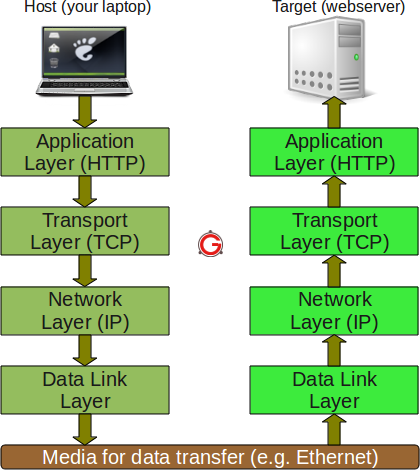Client requests for a service while the server processes the request for client.
Consider the data flow when you open a website.

As seen in the above figure, the information flows downward through each layer on the host machine. At the first layer, since http protocol is being used, so an HTTP request is formed and sent to the transport layer.
Here the protocol TCP assigns some more information(like sequence number, source port number, destination port number etc) to the data coming from upper layer so that the communication remains reliable i.e, a track of sent data and received data could be maintained.
At the next lower layer, IP adds its own information over the data coming from transport layer. This information would help in packet travelling over the network. Lastly, the data link layer makes sure that the data transfer to/from the physical media is done properly. Here again the communication done at the data link layer can be reliable or unreliable.
This information travels on the physical media (like Ethernet) and reaches the target machine.
Now, at the target machine (which in our case is the machine at which the website is hosted) the same series of interactions happen, but in reverse order.
The packet is first received at the data link layer. At this layer the information (that was stuffed by the data link layer protocol of the host machine) is read and rest of the data is passed to the upper layer.
Similarly at the Network layer, the information set by the Network layer protocol of host machine is read and rest of the information is passed on the next upper layer. Same happens at the transport layer and finally the HTTP request sent by the host application(your browser) is received by the target application(Website server).
.FOR BRIEF DISCRIPTION OF EACH LAYER CLICK ME
Consider the data flow when you open a website.

As seen in the above figure, the information flows downward through each layer on the host machine. At the first layer, since http protocol is being used, so an HTTP request is formed and sent to the transport layer.
Here the protocol TCP assigns some more information(like sequence number, source port number, destination port number etc) to the data coming from upper layer so that the communication remains reliable i.e, a track of sent data and received data could be maintained.
At the next lower layer, IP adds its own information over the data coming from transport layer. This information would help in packet travelling over the network. Lastly, the data link layer makes sure that the data transfer to/from the physical media is done properly. Here again the communication done at the data link layer can be reliable or unreliable.
This information travels on the physical media (like Ethernet) and reaches the target machine.
Now, at the target machine (which in our case is the machine at which the website is hosted) the same series of interactions happen, but in reverse order.
The packet is first received at the data link layer. At this layer the information (that was stuffed by the data link layer protocol of the host machine) is read and rest of the data is passed to the upper layer.
Similarly at the Network layer, the information set by the Network layer protocol of host machine is read and rest of the information is passed on the next upper layer. Same happens at the transport layer and finally the HTTP request sent by the host application(your browser) is received by the target application(Website server).
.FOR BRIEF DISCRIPTION OF EACH LAYER CLICK ME
- Network interface (layer 1): Deals with all physical components of network connectivity between the network and the IP protocol
- Internet (layer 2): Contains all functionality that manages the movement of data between two network devices over a routed network
- Host-to-host (layer 3): Manages the flow of traffic between two hosts or devices, ensuring that data arrives at the application on the host for which it is targeted
- Application (layer 4): Acts as final endpoints at either end of a communication session between two network hosts
No comments:
Post a Comment